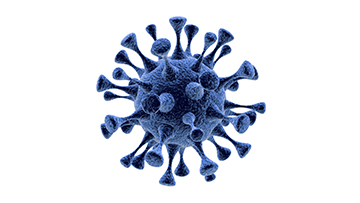
A significant portion of patients with COVID-19 infection experience acute kidney injury (AKI); rates of AKI among patients admitted to the intensive care unit (ICU) are very high. Reported rates among hospitalized patients range from 15% to 40%, and rates in patients admitted to the ICU exceed 50%. Approximately 5% of patients hospitalized with COVID-19 required renal replacement therapy (RRT); among patients in the ICU, up to 15% required RRT.
Mechanisms associated with AKI in COVID-19 include direct viral penetration of renal cells through the angiotensin converting enzyme 2 receptor. Renal failure can also result from indirect damage by the aberrant inflammatory response characteristic of COVID-19.
A severe inflammatory response to viral infection is not unique to SARS-CoV-2. AKI is also associated with other common respiratory viruses such as influenza and respiratory syncytial virus (RSV). Eden Shusterman, MD, and colleagues in Israel conducted a retrospective observational study in a tertiary medical center to compare the rate, risk factors, and prognostic value of AKI among those viruses. Results were reported online in the Journal of Nephrology [doi.org/10.1007/s40620-023-01591-2].
The cohort included three groups: (1) 2593 patients ≥18 years of age admitted to the Tel Aviv Sourasky Medical Center (TASMC) with a confirmed diagnosis of SARS-CoV-2 infection from March 2020 until November 2021; (2) 2041 patients with a confirmed diagnosis of influenza infection (A and B) admitted to TASMC between 2010 and 2020; and (3) 429 patients with a confirmed diagnosis of RSV admitted to TASMC from 2010 to 2020. Patients undergoing chronic RRT were excluded, as well as those for whom blood tests were not available.
Using patient chart reviews, the researchers obtained background data on sex, age, comorbidities, diagnoses known as risk factors for AKI in COVID-19 (hypertension, diabetes mellitus, multiple myeloma, heart failure, chronic kidney disease [CKD], and chronic use of specific medications [angiotensin converting enzyme inhibitors, angiotensin receptor blockers, or proven risk factors for COVID-19-related AKI such as diuretics]). Other data of interest were vital signs; laboratory data on blood count, blood chemistry, urine analysis, and blood gases; and general clinical outcomes (length of hospitalization, need for mechanical ventilation, and morbidity).
In general, patients in the RSV group were older and had more comorbidities compared with the other two groups. In the COVID-19 group, hypertension and diabetes mellitus were least common in contrast to the RSV group, where hypertension and diabetes mellitus were most common (P<.001 for hypertension and P<.05 for diabetes mellitus).
Patients with COVID-19 had the worst outcomes, with higher rates of death (18% vs 7% vs 13% for COVID-19, influenza, and RSV, respectively; P<.001) and higher rates of need for mechanical ventilation (13% vs 6% vs 8% for COVID-19, influenza, and RSV, respectively; P<.001). In the COVID-19 and influenza groups, those with AKI on admission had significantly longer lengths of stay.
Rates of AKI were measured at admission, at 48 hours, and within 7 days. Compared with the groups with influenza or RSV, those with COVID-19 had the lowest rates of AKI at all time points: at admission, 7.33 vs <8.04 vs <11.19 for COVID-19, influenza, and RSV, respectively (P=.03); after 48 hours, 2.97 vs <5.14 vs <8.16 for COVID-19, influenza, and RSV, respectively (P<.001); and within 7 days, 11.76 vs <13.28 vs <17.95 for COVID-19, influenza, and RSV, respectively (P=.002). No virus was an independent risk factor for AKI within 7 days or a risk factor for stage 3 AKI. Temporal patterns were similar in the three groups regarding creatinine dynamics, which was skewed to the first 48 hours of admission, with the highest proportion of patients reaching their maximal creatinine within 48 hours.
Across the three groups, CKD, high levels of phosphate, proteinuria, and blood urea nitrogen (BUN) were independent risk factors for developing AKI, as was elevated neutrophil to lymphocyte ratio within 48 hours of admission. For all three viruses, CKD, proteinuria, and high levels of phosphate and BUN on admission were predictors of stage 3 AKI. Higher phosphate levels on admission were a strong risk factor for stage 3 AKI. High ferritin levels and low oxygen saturation were independent risk factors for severe AKI in the COVID-19 group only.
In all three groups, there was a strong and independent association between development of AKI within the first 7 days of admission and the risk for adverse outcomes (death within 30 days or the need for mechanical ventilation). There was also a strong and independent association between developing stage 3 AKI within the first 7 days of AKI and the risk of adverse outcomes.
AKI on admission was a predictor of adverse outcomes only in the COVID-19 and influenza groups. AKI within the first 48 hours was a significant risk factor for adverse outcomes in all three groups. Patients in the COVID-19 and influenza groups whose creatinine continued or began to rise after more than 48 hours from admission had an increased risk for adverse outcomes.
The authors cited some limitations to the study, including the retrospective design and the asymmetrical temporal formation of the three groups. During the early phase of the COVID-19 pandemic, patients with mild symptoms were referred to the emergency department, while hospitalized patients were screened for COVID-19, which may have resulted in selection bias.
In conclusion, the researchers said, “Our study compared the renal risk factors, the outcomes, and the prognostic factors in patients affected by three respiratory viruses. To our knowledge, this is the first large-scale study reporting on renal injury in hospitalized RSV patients. We found that, despite the growing evidence for COVID-19 tropism and direct kidney injury, the incidence of acute kidney injury is not higher than that observed with other viruses. COVID-19 is unique, however, in the prognostic value of inflammatory markers for predicting renal injury, which may pertain to the specific role of the aberrant immune response in kidney damage. We were further able to define the prognostic value of AKI at several time points on the overall outcome. In the near future, when influenza, COVID-19, and RSV may circulate simultaneously, our findings could provide a virus-specific evaluation, allowing clinicians to estimate the expected renal and overall outcomes.”
Takeaway Points
- Patients with COVID-19 admitted to the intensive care unit have high rates of developing acute kidney injury (AKI).
- ResearcheRs in Israel compared rates, risk factors, and outcomes of AKI in patients with COVID-19 with those in patients with influenza (A and B) and patients with respiratory syncytial virus (RSV).
- The incidence of AKI was lower in patients with COVID-19 compared with patients with influenza or RSV. In all three viruses, AKI was a prognostic marker for adverse outcomes.
Source: Journal of Nephrology







 © 2025 Mashup Media, LLC, a Formedics Property. All Rights Reserved.
© 2025 Mashup Media, LLC, a Formedics Property. All Rights Reserved.